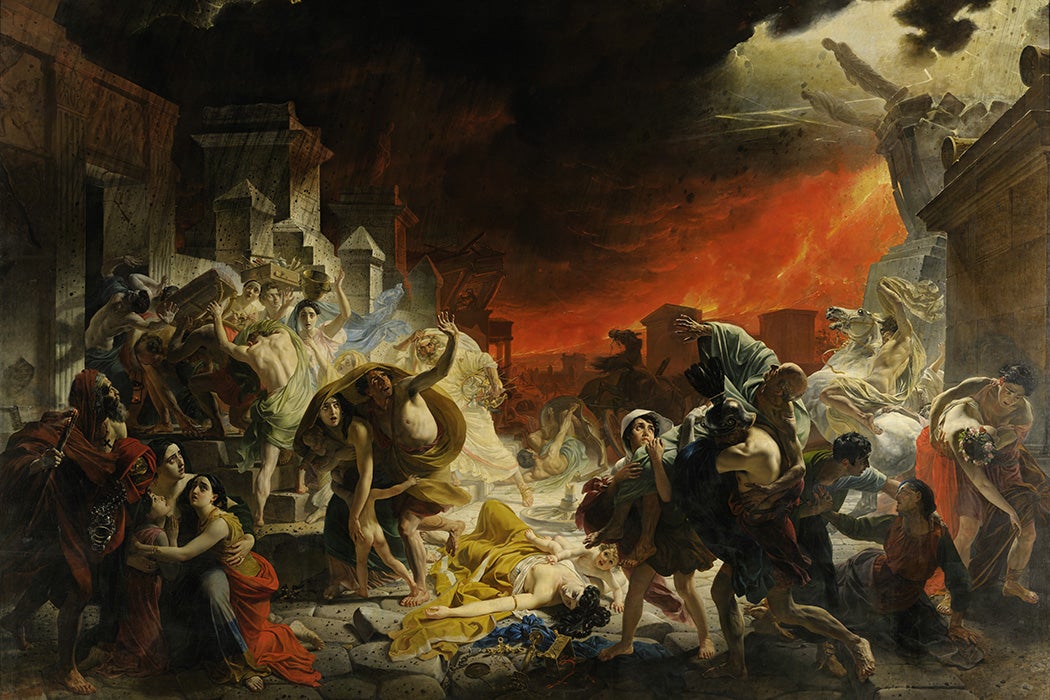In 1787, Goethe climbed the slopes of Mount Vesuvius and stood gazing into the smoking crater. In his diary, he recorded with disappointment that the freshest lava was already five days old, and that the volcano neither belched flame nor pelted him with stones.
It seems like an odd thing to wish for, but a truly terrifying experience of Vesuvius was one of the most coveted souvenirs of the European Grand Tour. To commemorate their trips, tourists decked themselves out in lava jewelry and commissioned paintings of the volcano in eruption, preferably with dramatic, glowing streams of lava running down the sides. The idea was to feel convincingly close to annihilation. Goethe wasn’t satisfied until he summited again, this time into a storm of blazing ash:
A violent thundering toned forth from its deepest abyss, then stones of larger and smaller sizes were showered into the air by thousands, and enveloped by clouds of ashes… We soon stood on the brink of the vast chasm, the smoke of which, although a gentle air was bearing it away from us, unfortunately veiled the interior of the crater, which smoked all round from a thousand crannies… of a sudden the thunder pealed aloud… we rushed down and reached the foot of the hill, together with the drizzling ashes, which pretty thickly covered our heads and shoulders.
Goethe described his narrow escape in a note to a friend, which carried a tangible souvenir of the adventure: the cover of the letter was “stained with smoke, in testimony of its having been with me on Vesuvius.” In 1631, Vesuvius burst back to life, after a long period of dormancy.
Just over a century later, in the mid-1700s, the remains of Pompeii were identified for the first time. The coincidence struck many with an eerie sense of predestination: the rediscovery of the buried city, lying in wait for a thousand years, had been heralded by the reawakening of its destroyer. It was the beginning of the Romantic era, and nothing appealed more perfectly to the Romantic sensibility than the mix of horror and awe evoked by the spectacle of the smoking mountain looming over the ash-choked city.
As Pompeii tourism boomed, people of all stripes were busily employed in the process of bringing the City of the Dead back to life. Novelists reanimated the tormented victims of Pompeii, turning them into heroes and villains, so that tourists wandering through the ruins might point to an ash-covered body and exclaim: “Look, it’s Calenus from The Last Days of Pompeii!” Local authorities developed a habit of staging excavations to impress visiting dignitaries: they would choose a few interesting antiquities, scatter a layer of dust over them, and then uncover them theatrically before the honored guest.
Why did the tourists flock to Pompeii? It seems that a city frozen in the moment of catastrophe is grimmer than a living city, but also, strangely, more intimate. The prime sites of Rome—the Forum, the Colosseum, the Pantheon—are all testaments to imperial power. Pompeii’s monuments, on the other hand, are accidental testaments to the banal: centuries-old loaves of bread, still waiting in their ovens, bowls of carbonized eggs, ready to be cracked. In Pompeii, the past feels both more vividly alive, and more disturbingly dead.
By the Victorian era, Pompeii was more alive than ever. In fact, it was metastasizing. Miniature faux-Pompeiis began to spring up all around Europe and North America. In London, you could stroll through a reproduction of a Pompeiian house in the Crystal Palace. In New York, you could spend the evening in Coney Island watching a “pyrodrama” of the destruction of Pompeii, with an imitation Vesuvius spewing fireworks for the grand finale. And in cities around the world, you could take in a panorama: a 360-degree view of Vesuvius painted around the inside of a circular tower—an experience which was, according to Blackwood’s Magazine, far superior to the real deal:
Panoramas are among the happiest contrivances for saving time and expense in this age of contrivances. What cost a couple of hundred pounds and half a year half a century ago, now costs a shilling and a quarter of an hour. Throwing out of the old account the innumerable miseries of travel, the insolence of public functionaries, the roguery of innkeepers, the visitations of banditti, charged to the muzzle with sabre, pistol, and scapulary, and the rascality of the custom-house officers, who plunder, passport in hand, the indescribable desagremens of Italian cookery, and the insufferable annoyances of that epitome of abomination, an Italian bed.
Perhaps the strangest attempt to export the Pompeiian experience, however, was Sir William Hamilton’s Vesuvian Apparatus—a bizarre device that seems to have been, at once, a scientific instrument, a parlor-entertainment, and an early precursor to the motion picture.
Weekly Newsletter
It was a cabinet fronted with a transparent painting of Vesuvius, and joined at the back to a kind of clockwork mechanism. When wound up and lit from behind, the apparatus presented a kind of proto-film: A rotating cylinder behind the translucent pane sent fluttering light through the image, making the volcano seen to stream glowing lava. Then a mallet would strike a concealed drum, letting off a convincingly volcanic BOOM!
Suddenly, the viewer was transported from the safety of their drawing room to the slopes of Vesuvius. Like Goethe on the mountaintop, they experienced the pleasure of being overawed. The miniature Vesuvius was a machine for producing a fleeting moment of the sublime.
Support JSTOR Daily! Join our new membership program on Patreon today.







